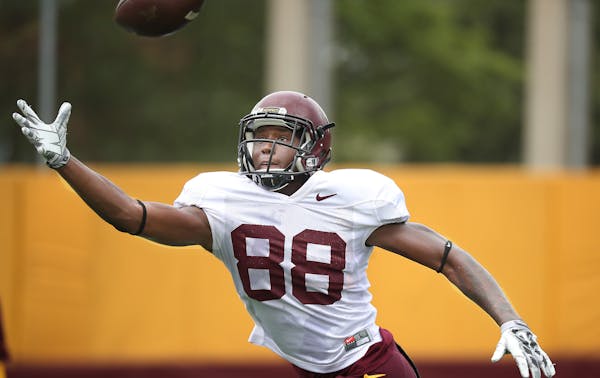Gophers football coach Tracy Claeys had the same reaction other television viewers did Sunday, when Texas' DeShon Elliott wasn't flagged for targeting on a crushing hit that gave Notre Dame receiver Torii Hunter Jr. a concussion.
"How is that not a defenseless hit?" Claeys said Tuesday, during his weekly KFAN (100.3-FM) show.
Claeys had reason to feel miffed. The Gophers had three players ejected for targeting in their season opener against Oregon State. This, after Minnesota had drawn only two targeting flags over the previous four years, both of which were overturned by replay.
The targeting rule — defined by the NCAA as "attacking with forcible contact," usually to the head and neck area of an opponent — actually hasn't changed much this season. The NCAA made a few tweaks — giving a replay official authority to call targeting from the booth if it's not called on the field, and labeling other players besides quarterbacks "defenseless" if they give themselves up by sliding.
But the Gophers' targeting infractions against Oregon State all could have been flagged in recent years. Chalk it up to a rare outbreak for Minnesota.
Linebacker Cody Poock is eligible to return from his targeting penalty for the first half of Saturday's Indiana State game. But linebacker Jonathan Celestin and defensive end Tai'yon Devers must sit for the first half against the Sycamores, because their penalties came in the second half.
"I'm a big fan of the rule," Claeys said during the Big Ten teleconference. "I think it needs to be in there. As we go along, hopefully that gray area [of what is and isn't targeting] can be eliminated. And plus, being able to tell the difference on which ones are unavoidable."
Claeys thinks one of Minnesota's three targeting penalties from last Thursday would fall into the "unavoidable" category.
Celestin lowered his head to make a third-quarter hit on Oregon State quarterback Darell Garretson. When Garretson slid, it was too late for Celestin to redirect and the tackle turned into a helmet-to-helmet collision.
At moments like that, it's difficult to "stop on a dime," Gophers senior Hank Ekpe said. He and fellow defensive end Gaelin Elmore had a good conversation about targeting with the referee, from the Pac-12 conference, right after the Celestin call.
"The ref was just explaining it to us," Ekpe said. "I mean, the refs were just doing their jobs. They're doing their best to protect the quarterbacks, protect the offense, protect players in general."
The Gophers had no qualms with the other two calls.
In the first quarter, Garretson threw a third-down incompletion, which would have forced Oregon State to punt. But Poock decked receiver Jordan Villamin, drawing a targeting penalty that extended the eventual touchdown drive.
"Anytime you leave your feet, it's considered a launch, and [the players] know that," Claeys said. "So that's got to be taken care of. But I'm also not going to take the aggression out of it. If we … lowered the target, it hadn't been a problem."
A targeting penalty spoiled an otherwise spectacular college debut for Devers. Twice in the second quarter, he had raced around the edge and drilled Garretson, forcing fumbles that led to Gophers touchdowns. But in the fourth quarter, Devers hit the 6-foot Garretson again, this time right in the helmet.
"Kids got a little excited," Claeys said. "Tai'yon's a young kid. He's got to learn. And we were playing against a shorter quarterback, too. The zone on the quarterback is really smaller than a strike zone in baseball."
The difference, Claeys said, is a hitter in baseball isn't running full-speed.
Claeys said Gophers players are taught to aim for a spot "below the top of the numbers."
"We'll continue to work on lowering the target in practice," Claeys said. "But it hasn't been a problem in the past, and I don't see it being a problem the rest of the year."
